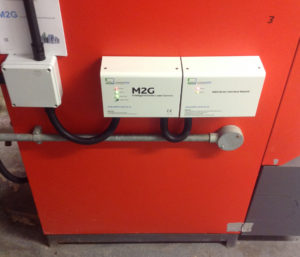 Boiler load optimisation controls will save Sidney Sussex College over £9,500 a year and result in avoided CRC costs of over £3,500 over five years, according to Sabien. In this sponsored post, the firm explains that the estate-wide installation of controls should pay back in just over two years, according to savings verified from installing an initial M2G unit on one boiler.
Boiler load optimisation controls will save Sidney Sussex College over £9,500 a year and result in avoided CRC costs of over £3,500 over five years, according to Sabien. In this sponsored post, the firm explains that the estate-wide installation of controls should pay back in just over two years, according to savings verified from installing an initial M2G unit on one boiler.
The college, a constituent college of the University of Cambridge, installed Sabien’s M2G boiler load optimisation controls across its estate after seeing a 17% reduction in oil consumption during the measurement and verification phase of the project.
An M2G was installed in one boiler house to verify the level of savings. Energy consumption data was provided to Sabien which was then analysed to establish the level of energy savings using the CuSUM methodology. The analysis demonstrated a 17% reduction in oil consumption so M2G controls were installed on the remaining 11 boilers.
The boilers varied in age and size and there was no downtime to the College’s operations during the installations. Using the 17% savings initially verified, it is estimated the project will pay back in 2.1 years, saving the college over £9,500 a year and resulting in avoided CRC costs of over £3,500 over five years.
“Reducing our heating consumption and the associated oil costs is a key objective for the College and Sabien’s M2Gs are playing a key role in achieving this,” said Keith Willox, Domus Bursar for Sidney Sussex College. “There was minimal disruption to our operations throughout the whole project. Sabien provided complete end-to-end project management, including the measurement and verification, commissioning and installations of the M2Gs” he added.
How it works
The patented M2G was introduced in 2004 to provide effective control of boiler dry cycling without the disadvantages of previous technologies which had relied on either a fixed time delay with no temperature sensors or lowering the boilers’ operating temperatures.
M2G technology uses flow and return temperature sensors to monitor, analyse and control the flow and return temperatures of the boiler in real time. It recalculates the values every time the boiler reaches its required set point temperature. This means it adapts to BMS/optimiser variable set-points and does nothing to conflict with other existing controls such as weather compensation, demand control or sequencing. The boilers’ designed set points are never altered.
Therefore it can determine the actual heating demand on the boiler and prevent it from dry cycling without lowering the system temperature or using a fixed time delay. Furthermore, all of the verified savings delivered by these retrofit controls are actual kWh savings in gas consumption – not the reduction in firing time that some manufacturers promote. The latter, warns Sabien, has no relation to the money spent when high/low or modulating burners are used.
The company claims that, due to its compatibility with other boiler controls that may be in use, intelligent boiler load optimisation adds to the energy savings already being achieved by these other controls and will typically deliver a payback in less than 18 months. Sabien says that claim is based on installation of 9,000 units worldwide with subsequent verification of savings in line with the International Performance Measurement and Verification Protocol (IPMVP).
Further information, including a video that explains boiler dry cycling, is available at www.sabien-tech.co.uk
Follow us at @EnergystMedia. For regular bulletins, sign up for the free newsletter.



